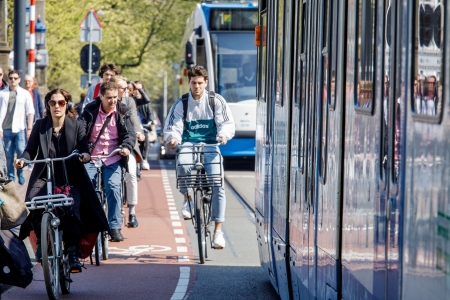Registered crashes show that particularly vulnerable road users are involved in public transport crashes. For that reason, locations shared by buses/trams and vulnerable road users are most risky.
Bus and tram stops are a weak part of the public transport infrastructure in terms of road safety. 1998 research of tram crashes shows that, in order to catch the tram, pedestrians cross the road at the location of the tram stop and do not always use pedestrian crossings [6]. To discourage such ‘illegal’ crossing behaviour, fences are often installed between the stop tracks. This tram stop layout is not always uniform [7]. which runs counter to one of the principles for safe road design (see SWOV Fact sheet Principles for safe road design). Design uniformity strengthens the recognisability and predictability of traffic and helps reduce human errors [8].
Tram rails are hazardous for – especially – cyclists. Their bicycle wheels may slip into the rails and they may take a fall. Other (or motorised) two-wheelers may skid on the slippery tracks in wet weather conditions [9] [10].
In Melbourne, research has shown that buses are less often involved in crashes when they drive on designated bus lanes (mostly at the right side of the road [11]). Designated tram tracks and bus lanes seem safer than roads which allow trams and buses to mingle with other traffic [12]. At the same time, drivers turning into a side street may run into conflict with buses, and pedestrians will have to cross a wider road which leads to a higher risk. In addition, sufficient space for widening the road to create a bus lane is not always available [11]. When building a bus lane it is important to limit speed differences between buses and other road users and to safeguard interaction between buses and other, mainly vulnerable, road users (such as pedestrians and cyclists [12].
